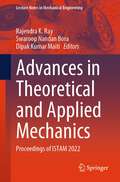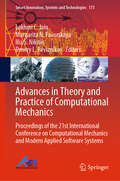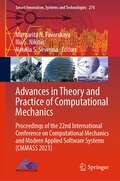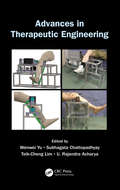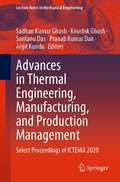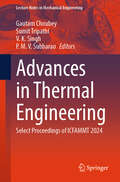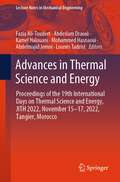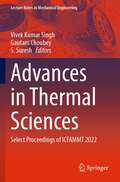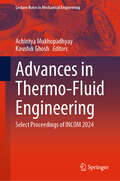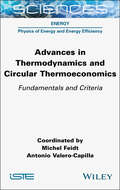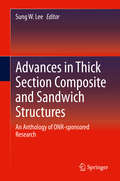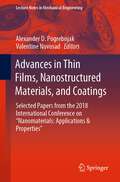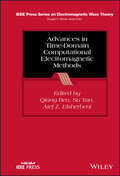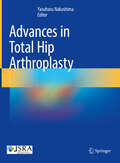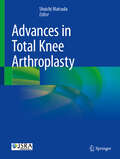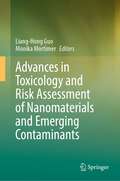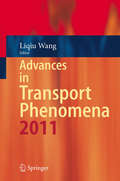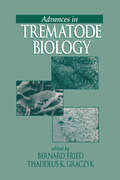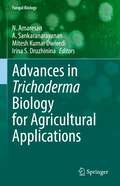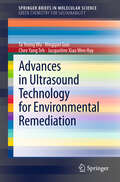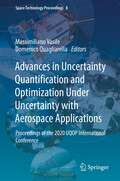- Table View
- List View
Advances in Theoretical and Applied Mechanics: Proceedings of ISTAM 2022 (Lecture Notes in Mechanical Engineering)
by Dipak Kumar Maiti Rajendra K. Ray Swaroop Nandan BoraThis book presents select proceedings of the 67th Congress of the Indian Society of Theoretical and Applied Mechanics (ISTAM-2022). The content includes chapters on topics such as fluid mechanics, aerospace dynamics, atmospheric sciences and oceanography, geophysical environmental fluid dynamics, biomechanics, computational fluid dynamics, experimental methods in fluid dynamics, mathematical modelling, statistical mechanics, computational solid mechanics, experimental method in solid mechanics, mechanics of composites, and robotics and control. The book will be a valuable reference for researchers and professionals interested in applied and computational mechanics and allied fields.
Advances in Theory and Practice of Computational Mechanics: Proceedings of the 21st International Conference on Computational Mechanics and Modern Applied Software Systems (Smart Innovation, Systems and Technologies #173)
by Lakhmi C. Jain Margarita N. Favorskaya Ilia S. Nikitin Dmitry L. ReviznikovThis book discusses physical and mathematical models, numerical methods, computational algorithms and software complexes, which allow high-precision mathematical modeling in fluid, gas, and plasma mechanics; general mechanics; deformable solid mechanics; and strength, destruction and safety of structures. These proceedings focus on smart technologies and software systems that provide effective solutions to real-world problems in applied mechanics at various multi-scale levels. Highlighting the training of specialists for the aviation and space industry, it is a valuable resource for experts in the field of applied mathematics and mechanics, mathematical modeling and information technologies, as well as developers of smart applied software systems.
Advances in Theory and Practice of Computational Mechanics: Proceedings of the 22nd International Conference on Computational Mechanics and Modern Applied Software Systems (CMMASS 2021) (Smart Innovation, Systems and Technologies #274)
by Margarita N. Favorskaya Ilia S. Nikitin Natalia S. SeverinaThis book is a collection of peer-reviewed best selected research papers presented at 22nd International Conference on Computational Mechanics and Modern Applied Software Systems (CMMASS 2021), held at the Alushta Health and Educational Center, The Republic of Crimea, during 4–13 September 2021. The proceedings is dedicated to solving the real-world problems of applied mechanics using smart computational technology. Physical and mathematical models, numerical methods, computational algorithms and software complexes are discussed, which allow to carry out high-precision mathematical modelling in fluid, gas and plasma mechanics, in general mechanics, deformable solid mechanics, in strength, destruction and safety of structures, etc. Smart technologies and software systems that provide effective solutions to the problems at various multi scale-levels are considered. Special attention is paid to the training of highly qualified specialists for the aviation and space industry.
Advances in Therapeutic Engineering
by U. Rajendra Acharya Teik-Cheng Lim Wenwei Yu Subhagata ChattopadhyayTherapeutic Engineering (TE) is a cutting-edge domain in today's era of medical technology research. Through engineering algorithms that provide technological solutions, it aims to elevate the quality of life of disabled individuals. Advances in Therapeutic Engineering describes various therapeutic processes and mechanisms currently applied to the
Advances in Thermal Engineering, Manufacturing, and Production Management: Select Proceedings of ICTEMA 2020 (Lecture Notes in Mechanical Engineering)
by Santanu Das Sadhan Kumar Ghosh Koushik Ghosh Pranab Kumar Dan Arijit KunduThis book presents the selected peer-reviewed proceedings of the International Conference on Thermal Engineering and Management Advances (ICTEMA 2020). The contents discuss latest research in the areas of thermal engineering, manufacturing engineering, and production management. Some of the topics covered include multiphase fluid flow, turbulent flows, reactive flows, atmospheric flows, combustion and propulsion, computational methods for thermo-fluid arena, micro and nanofluidics, renewable energy and environment sustainability, non-conventional energy resources, energy principles and management, machine dynamics and manufacturing, casting and forming, green manufacturing, production planning and management, quality control and management, and traditional and non-traditional manufacturing. The contents of this book will be useful for students, researchers as well as professionals working in the area of mechanical engineering and allied fields.
Advances in Thermal Engineering: Select Proceedings of ICFAMMT 2024 (Lecture Notes in Mechanical Engineering)
by V. K. Singh P. M. V. Subbarao Gautam Choubey Sumit TripathiThe 2nd International Conference on Futuristic Advancements in Materials, Manufacturing and Thermal Sciences (ICFAMMT-2024) was jointly organized by the Department of Mechanical and Aerospace Engineering, Institute of Infrastructure, Technology, Research and Management (IITRAM), Ahmedabad, India, and the Space Society of Mechanical Engineers (SSME), Space Applications Centre, ISRO, Ahmedabad. This conference aims to provide splendid opportunities for academicians, researchers, industrial persons, and young scientists to address new challenges and discuss futuristic advancements in materials, manufacturing, and thermal sciences. This book includes select peer-reviewed proceedings of the 2nd International Conference on Futuristic Advancements in Materials, Manufacturing and Thermal Sciences (ICFAMMT 2024). The contents of this book provide an overview of the latest research in the area of thermal and fluid sciences such as computational and numerical methods in fluid flow and heat transfer, advanced energy systems, battery thermal management system, technologies for space, and aerospace applications, supersonic combustion, two-phase/multiphase flows, measurement and instrumentation for fluid flow and transport properties, micro/nano-scale fluid flow and heat transfer. The book is useful for researchers and professionals working in the field of thermal and fluid sciences.
Advances in Thermal Science and Energy: Proceedings of the 19th International Days on Thermal Science and Energy, JITH 2022, November 15–17, 2022, Tangier, Morocco (Lecture Notes in Mechanical Engineering)
by Fazia Ali-Toudert Abdeslam Draoui Kamel Halouani Mohammed Hasnaoui Abdelmajid Jemni Lounès TadristThis book covers advanced theories and methods in the field of heat and mass transfer, which are expected to improve thermal systems performance and energy efficiency. It reports on novel findings relating to a wide range of topics in industry, building, transportation and agriculture. Offering a good balance of fundamental and applied research, this book provides scientists, engineers and other professionals with a timely snapshot on advances in thermal science, renewable energies and sustainable energy technologies. It also offers a source of inspiration for future research and collaborations.
Advances in Thermal Sciences: Select Proceedings of ICFAMMT 2022 (Lecture Notes in Mechanical Engineering)
by S. Suresh Vivek Kumar Singh Gautam ChoubeyThis book presents select peer-reviewed proceedings of the International Conference on Futuristic Advancements in Materials, Manufacturing and Thermal Sciences (ICFAMMT 2022). The book provides an overview of the latest research in the area of thermal sciences such as computational and numerical methods in fluid flow and heat transfer, advanced energy systems, optimization of thermal systems, technologies for space, and aerospace applications, supersonic combustion, two-phase / multiphase flows. The book will be useful for researchers and professionals working in the field of thermal sciences
Advances in Thermo-Fluid Engineering: Select Proceedings of INCOM 2024 (Lecture Notes in Mechanical Engineering)
by Achintya Mukhopadhyay Koushik GhoshThis book presents selected extended papers from the International Conference on Mechanical Engineering (INCOM 2024), describing recent advances in thermo-fluids engineering research. Various topics covered in this book are design and analysis of thermal systems, dynamics and control of thermal systems and processes, fluid mechanics, fluid–structure interaction, heat transfer, internal combustion engines and gas turbines, multiphase flow, and heat transfer. The book is a valuable reference for researchers and professionals working in the fields of mechanical, aerospace, chemical, and power engineering and also for a number of interdisciplinary areas like materials processing, electronic, and energy storage systems where thermal management is a key design issue.
Advances in Thermodynamics and Circular Thermoeconomics: Fundamentals and Criteria
by Michel Feidt Antonio Valero-CapillaThis book on energy physics and energy efficiency discusses two essential components of energy physics: the fundamentals and the criteria. It covers the historical basis of Carnot models, the thermostatic cycles of double-function heat pumps and the optimization of thermomechanical engines, and discusses the results of various investigations, bringing together a number of previous works. The latter half of this book introduces the concept of "Circular Thermoeconomics" and assesses the physical costs of recycling waste in increasingly complex industrial processes. It then goes on to present "Relative Free Energy", allowing us to create a new mathematical theory of thermodynamic costs in order to diagnose malfunctions in thermal systems. The book shows the progression of knowledge on the existence of successive energy, power and efficiency, and pairs this with the economic aspects, which are already becoming linked to growing environmental concerns.
Advances in Thermofluids and Renewable Energy: Select Proceedings of TFRE 2020 (Lecture Notes in Mechanical Engineering)
by Pinakeswar Mahanta Pankaj Kalita Anup Paul Abhik BanerjeeThis book comprises the select proceedings of the International Conference on Recent Trends in Developments of Thermofluids and Renewable Energy (TFRE 2020). The major topics covered include aerodynamics, alternate energy, bio fuel, bio heat transfer, computational fluid dynamics, control mechanism for constant power generation, and energy storage. The book also discusses latest developments in the fields of electric vehicles, hybrid power systems, and solar and renewable energy. Given the scope of its contents, this book will be useful for students, researchers, and professionals interested in the field of thermofluids and renewable energy resources.
Advances in Thick Section Composite and Sandwich Structures: An Anthology of ONR-sponsored Research
by Sung W. LeeThis book describes recent research findings on response and integrity of thick section composite and sandwich structures. In particular, it deals with these structures for marine applications under static and dynamic loads such as shock and slamming loads in severe sea environment including sea water, temperature extremes, hydrostatic pressure and Arctic conditions. Three-dimensional constitutive equations and failure criteria for structural response and integrity are considered. The book serves as an excellent repository of major advances in research on response and integrity of composite and sandwich structures made through research grants sponsored by the U.S. Office of Naval Research in the past decade. Collects major advances in response and integrity research;Emphasizes phenomena within severe environments;Illustrates underwater fluid-structure interactions, shock/blast loads, and slamming loads.
Advances in Thin Films, Nanostructured Materials, and Coatings: Selected Papers from the 2018 International Conference on “Nanomaterials: Applications & Properties” (Lecture Notes in Mechanical Engineering)
by Alexander D. Pogrebnjak Valentine NovosadThis book highlights the latest advances in chemical and physical methods for thin-film deposition and surface engineering, including ion- and plasma-assisted processes, focusing on explaining the synthesis/processing–structure–properties relationship for a variety of thin-film systems. It covers topics such as advances in thin-film synthesis; new thin-film materials: diamond-like films, granular alloys, high-entropy alloys, oxynitrides, and intermetallic compounds; ultra-hard, wear- and oxidation-resistant and multifunctional coatings; superconducting, magnetic, semiconducting, and dielectric films; electrochemical and electroless depositions; thin-film characterization and instrumentation; and industrial applications.
Advances in Time-Domain Computational Electromagnetic Methods (IEEE Press Series on Electromagnetic Wave Theory)
by Qiang Ren Atef Z. Elsherbeni Su YanAdvances in Time-Domain Computational Electromagnetic Methods Discover state-of-the-art time domain electromagnetic modeling and simulation algorithms Advances in Time-Domain Computational Electromagnetic Methods delivers a thorough exploration of recent developments in time domain computational methods for solving complex electromagnetic problems. The book discusses the main time domain computational electromagnetics techniques, including finite-difference time domain (FDTD), finite-element time domain (FETD), discontinuous Galerkin time domain (DGTD), time domain integral equation (TDIE), and other methods in electromagnetic, multiphysics modeling and simulation, and antenna designs. The book bridges the gap between academic research and real engineering applications by comprehensively surveying the full picture of current state-of-the-art time domain electromagnetic simulation techniques. Among other topics, it offers readers discussions of automatic load balancing schemes for DG-FETD/SETD methods and convolution quadrature time domain integral equation methods for electromagnetic scattering. Advances in Time-Domain Computational Electromagnetic Methods also includes: Introductions to cylindrical, spherical, and symplectic FDTD, as well as FDTD for metasurfaces with GSTC and FDTD for nonlinear metasurfaces Explorations of FETD for dispersive and nonlinear media and SETD-DDM for periodic/ quasi-periodic arrays Discussions of TDIE, including explicit marching-on-in-time solvers for second-kind time domain integral equations, TD-SIE DDM, and convolution quadrature time domain integral equation methods for electromagnetic scattering Treatments of deep learning, including time domain electromagnetic forward and inverse modeling using a differentiable programming platform Ideal for undergraduate and graduate students studying the design and development of various kinds of communication systems, as well as professionals working in these fields, Advances in Time-Domain Computational Electromagnetic Methods is also an invaluable resource for those taking advanced graduate courses in computational electromagnetic methods and simulation techniques.
Advances in Topology, Dynamical Systems and Interdisciplinary Applications (Industrial and Applied Mathematics)
by Bipan Hazarika Santanu Acharjee Dragan S. DjordjevicThis book contains selected chapters on topology and dynamical systems and their interdisciplinary applications. Targeting researchers in interdisciplinary areas, the book covers contemporary interdisciplinary topics in topology and dynamical systems, such as closure functions, Partially Negative Dimensional Product (PNDP) manifolds, Khalimsky topological subspaces, neutrosophic topological space, ideal topological spaces, relator spaces, predator–prey symbiosis, cosmological models, and nanofluids.
Advances in Total Hip Arthroplasty
by Yasuharu NakashimaThis book provides comprehensive, evidence-based surgical principles and techniques for total hip arthroplasty (THA), covering all aspects of this procedure, including the history, biomaterials, biomechanics, surgical techniques and other important issues. Beginning with an overview of the hip joint and its anatomy, the authors detail the biomechanics of the hip joint in its various states and further discuss the properties of biomaterials in arthroplasty. The book describes the principles of surgical technique, preoperative planning, surgical procedures, rehabilitation, and management of complications, and thoroughly illustrates surgical procedures to enhance the reader's understanding. The book also introduces the technical aspects of the procedure, including how to deal with difficult cases such as severely deformed cases and how to increase the safe range of motion. Advances in Total Hip Arthroplasty is written by a pioneering team of authors in cooperation with the Japanese Society for Replacement Arthroplasty (JSRA). The book is informative and provides practical tips for THA and academic insights for orthopedic surgeons and residents specializing in arthroplasty. The translation was done with the help of an artificial intelligence machine translation tool. A subsequent human revision was done primarily in terms of content.
Advances in Total Knee Arthroplasty
by Shuichi MatsudaThis book describes in full detail the surgical principles and technology of Total Knee Arthroplasty (TKA), providing evidence-based data on the biomechanics of the knee joint and biomaterials in arthroplasty. Starting the chapters with the history and anatomy, the book expands its focus on important issues such as implant designs of articular geometry and ligament substitution. It describes the thorough procedures of surgery from planning, operation, discussion on how to improve the range of motion, postoperative rehabilitation and also patient satisfaction. In chapters describing the surgical procedures, and approaches, step-by-step surgical techniques are shown to manage various severe deformities. Also, the clinical relevance of surgical techniques including soft tissue balancing and alignment of the components and computer-simulated studies are of importance to highlight. Advances in Total Knee Arthroplasty invite authors who are surgeons who have extensive experience in severely deformed joints. This book is collaborated with the Japanese Replacement Arthroplasty Society (JSRA), and it is an informative material for collecting academic insights for arthroplasty surgeons and orthopaedic residents. The translation was done with the help of artificial intelligence. Subsequently, human revisions were made, mainly in terms of content. Subsequently, stylistic revisions were made by a specialized copy editor.
Advances in Toxicology and Risk Assessment of Nanomaterials and Emerging Contaminants
by Liang-Hong Guo Monika MortimerThis book details the state-of-the-art methodological advances for delineating the toxicology and working mechanisms of nanomaterials, microplastics, fine aerosol particulates (PM2.5) as well as emerging organic pollutants. It also provides latest computational approaches for toxicity prediction and risk assessment of nanoscale materials which possess realistic chances to enter the environment and human organism. Written by leading scientists at the frontiers of environmental science and nanomedicine, this book is intended for both young researchers and experienced professionals working in the fields of environmental protection, human health and occupational safety, nanotechnology, material science and nanomedicine, as well as graduate students majoring in environmental and health sciences.
Advances in Transitional Flow Modeling: Applications to Helicopter Rotors (SpringerBriefs in Applied Sciences and Technology)
by Chunhua ShengThis book provides a comprehensive description of numerical methods and validation processes for predicting transitional flows based on the Langtry-Menter local correlation-based transition model, integrated with both one-equation Spalart-Allmaras (S-A) and two-equation Shear Stress Transport (SST) turbulence models. A comparative study is presented to combine the respective merits of the two coupling methods in the context of predicting the boundary-layer transition phenomenon from fundamental benchmark flows to realistic helicopter rotors. The book will of interest to industrial practitioners working in aerodynamic design and the analysis of fixed-wing or rotary wing aircraft, while also offering advanced reading material for graduate students in the research areas of Computational Fluid Dynamics (CFD), turbulence modeling and related fields.
Advances in Transport Phenomena 2011 (Advances in Transport Phenomena #3)
by Liqiu WangThis new volume of the annual review "Advances in Transport Phenomena" series contains three in-depth review articles on the microfluidic fabrication of vesicles, the dielectrophoresis field-flow fractionation for continuous-flow separation of particles and cells in microfluidic devices, and the thermodynamic analysis and optimization of heat exchangers, respectively.
Advances in Trematode Biology
by Bernard Fried Thaddeus K. GraczykTrematodology - the study of a class of medically important parasitic, flat-bodied worms - has made significant advances over the past ten years. The tremendous amount of information accumulated from research discoveries and technical developments related to trematode biology makes this book a timely and necessary part of the literature. Advances in Trematode Biology presents a thorough treatment of modern trematodology, including principles and practices. With coverage of background material as well as modern methods, Advances in Trematode Biology updates researchers, practitioners, and students with new information in immunology, biochemistry, physiology, and molecular biology. Advances in Trematode Biology includes practical information on parasitological techniques, emphasizing species of medical and veterinary importance - a key reference for parasitologists, biologists, medical, and veterinary personnel. The excellent presentation of material, including well-organized tables and chapters, make Advances in Trematode Biology easy to use both as a textbook and as a reference.
Advances in Trichoderma Biology for Agricultural Applications (Fungal Biology)
by Irina S. Druzhinina A. Sankaranarayanan N. Amaresan Mitesh Kumar DwivediAdvances in Trichoderma Biology for Agricultural Applications covers the beneficial properties of Trichoderma in enhancing global agricultural productivity. Trichoderma are biotechnologically significant fungi, being widely used both agriculturally and industrially. In many cases Trichoderma are also a potential drug source of clinical importance. In recent years, driven by advances in genetics and genomics, research on these fungi has opened new avenues for its various applications. This book covers i) Current state of Trichoderma taxonomy, and species identification, ii) Trichoderma and plant-pathogenic fungi interactions, iii) Trichoderma interactions with plants, including rhizosphere competence of Trichoderma, antagonistic potentials, plant growth promotion, and management of various abiotic stresses in plants, iv) Practical aspects of Trichoderma commercialization in agriculture, v) Biosynthesis of metal-based nanoparticles and its application, and vi) Negative impact of Trichoderma strains in the environments.Reading this book should kindle further discussions among researchers working in fungal biotechnology, microbiology, agriculture, environmental science, forestry, and other allied subjects and thus lead to a broader scope of Trichoderma-based products and technologies. The knowledge shared in this book should also provide a warning on the potential risks associated with Trichoderma.
Advances in Tropical Crop Protection
by Mui-Yun WongThis book presents research findings on newly discovered pests and diseases that may be impacted by climate change in the tropics; current management techniques including molecular diagnostics, integrated pest management (IPM), and agroecological approach; and recent technological advancements used as preventive and curative approaches to mitigate the effects of plant pests and diseases. Combining the expertise of leading researchers in the various fields, the book provides a useful reference for all relevant stakeholders. The proposed book is prepared with the aim of disseminating the current research development of emerging pests and diseases in the tropics in the era of climate change as well as new and eco-friendly pest and disease management technologies of tropical crops. The book is divided into three parts with sixteen chapters. Part 1: Advances in Tropical Insect Pest Management consists of five chapters describing the discovery, formulations, and applications of nature-based solutions such as natural enemies of insects, insect hormones, botanicals, and microorganisms for sustainable pest management. Part 2: Advances in Tropical Plant Disease Management consists of seven chapters, describing the causal agents of economically important diseases of tropical crops, rapid pathogen detection systems as well as effective and sustainable disease management strategies. Part 3: Advances in Other Tropical Pests Management consists of four chapters detailing the various eco-friendly pest management of vertebrates, mollusks, weeds, and emerging IR4.0 technologies in pest management. Ideas for future volumes on this subject: Volume II would be a follow-up to Volume I. It covers emerging pests and diseases of the tropics in greater depth, with a focus on specific hosts and diseases. Robust pests and disease management technologies utilized in crop protection in tropical areas by the farmers will be discussed as well.
Advances in Ultrasound Technology for Environmental Remediation (SpringerBriefs in Molecular Science)
by Ningqun Guo Ta Yeong Wu Jacqueline Xiao Hay Chee Yang TehOver the past ten years, innovative technologies have shown that advanced oxidation processes are highly promising when applied to the remediation of polluted water or wastewater as they don't generate any sludge or solid material of hazardous nature. Advances in Ultrasound Technology for Environmental Remediation reviews the fundamentals of ultrasound technology and the state of the art developments in "ultrasound-based free radical generation" in environmental remediation and pollution prevention. It also presents the challenges of introducing ultrasound technology into large-scale environmental remediation applications and examines the methods used to improve ultrasound technology. Indeed, ultrasonic systems are extremely sensitive and vulnerable to operational parameters which cannot be controlled without a good knowledge and understanding of physical and chemical phenomena. Advances in Ultrasound Technology for Environmental Remediation features the theory and fundamentals of ultrasound technology and discusses its potential as an alternative method in environmental remediation.
Advances in Uncertainty Quantification and Optimization Under Uncertainty with Aerospace Applications: Proceedings of the 2020 UQOP International Conference (Space Technology Proceedings #8)
by Massimiliano Vasile Domenico QuagliarellaThe 2020 International Conference on Uncertainty Quantification & Optimization gathered together internationally renowned researchers in the fields of optimization and uncertainty quantification. The resulting proceedings cover all related aspects of computational uncertainty management and optimization, with particular emphasis on aerospace engineering problems. The book contributions are organized under four major themes: Applications of Uncertainty in Aerospace & EngineeringImprecise Probability, Theory and ApplicationsRobust and Reliability-Based Design Optimisation in Aerospace EngineeringUncertainty Quantification, Identification and Calibration in Aerospace Models This proceedings volume is useful across disciplines, as it brings the expertise of theoretical and application researchers together in a unified framework.
